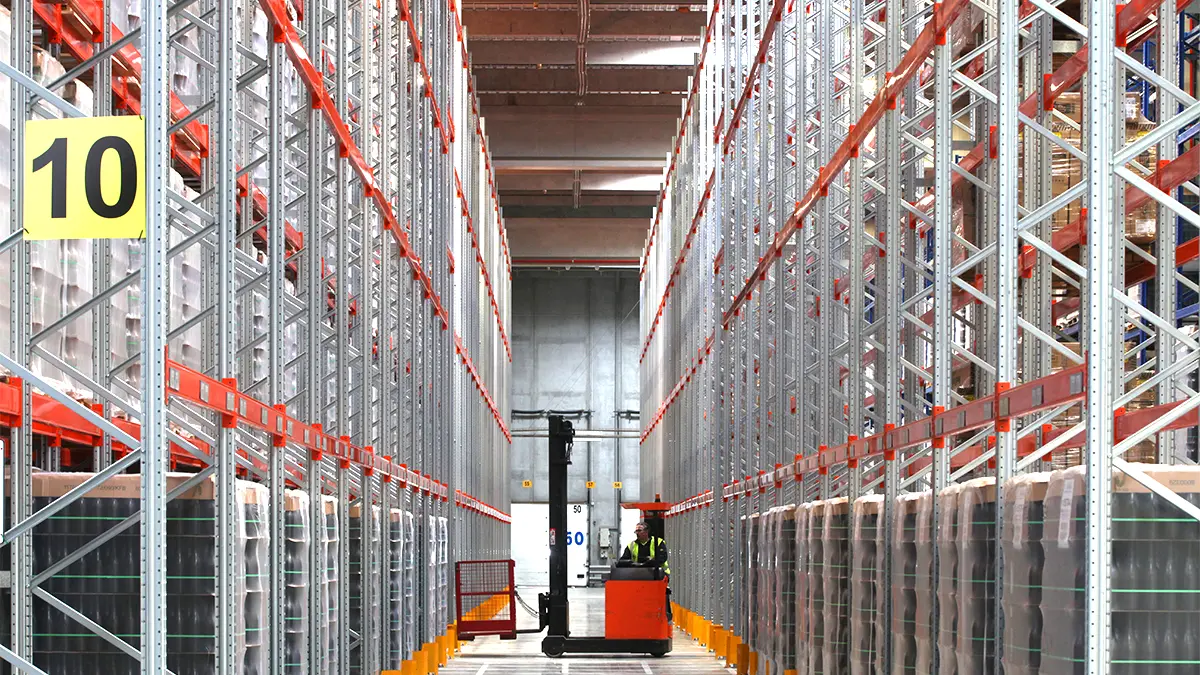In an increasingly volatile logistics environment, characterized by demand uncertainty, operational fragmentation, and pressure to reduce costs, controlling the flow of goods is more complex than ever. Within this context, the Bullwhip Effect emerges as a phenomenon that amplifies variability in orders throughout the different links of the supply chain, leading to operational inefficiencies, increased inventory levels, and deteriorated customer service.
This article provides a technical and strategic perspective on the Bullwhip Effect through the lens of logistics engineering, analyzing how advanced warehouse management, forecasting systems, and digitalization can play a vital role in mitigating it. AR Racking, a benchmark in industrial storage solutions, contributes with systems that enhance visibility, operational stability, and responsiveness to demand fluctuations.
What is the Bullwhip Effect?
The Bullwhip Effect occurs when small fluctuations in final consumer demand result in much larger changes upstream in the supply chain. This distortion is caused by reactive decision-making, a lack of synchronization among supply chain partners, and forecasting models that are misaligned with actual demand.
For example, a slight change in a retail store’s orders may prompt its distribution center to significantly increase its inventory out of fear of a stockout. This same pattern is repeated by manufacturers and raw material suppliers, amplifying the initial effect.
Factors such as lack of demand visibility, inaccurate forecasting, batch ordering, and the absence of system integration cause the supply chain to behave in a disjointed manner, leading to:
- Excessive inventory levels
- Overstocking in warehousing and transportation
- Low product turnover
- Increased logistics and financial costs
- Obsolescence risk
Direct consequences in planning, inventory, and transportation
From a logistics engineering standpoint, the Bullwhip Effect has critical implications across several operational areas:
Demand planning becomes unstable, forcing high safety margins that undermine efficiency. Inventory, in both quantity and location, becomes misaligned with real demand, complicating stock management and generating hidden costs due to unnecessary storage or unexpected stockouts.
In transportation, activity peaks overwhelm installed capacity, generating extra costs from emergency outsourcing or inefficient use of logistics resources.
The impact also affects workforce productivity, which must respond to abrupt workload changes. This disrupts proper planning with tools such as Labor Management Systems (LMS), as irregular flow affects the efficient assignment of tasks and shifts.

The role of industrial storage in demand variability
The warehouse, as a critical node in the supply chain, plays a key role in absorbing variability. A poorly scaled, rigid, or non-adaptable storage system can worsen the effects of the Bullwhip, becoming an operational bottleneck.
On the other hand, an optimized storage infrastructure designed to support high-variability environments can act as a logistics buffer, allowing for better handling of demand peaks, improving service quality, and reducing operational losses.
Some key principles in storage configuration to counter the Bullwhip include:
- Structural flexibility to adapt to volume variations
- Quick access to critical SKUs
- Seamless integration with forecasting and inventory systems
- Layouts that support efficient flow and reduced response times
AR Racking systems as technical support for operational stability
The storage solutions developed by AR Racking provide strength and flexibility to address supply chain disruptions. Its catalog of systems allows the warehouse layout to be adapted to the specific characteristics of demand, product type, and turnover rate.
The following are the most effective systems to mitigate the Bullwhip Effect:
- Selective Pallet Racking: Provides direct access to each SKU, ideal for environments with high order variability and product rotation.
- Pallet Flow Racking (FIFO): Ensures efficient stock management through first-in, first-out movement, essential for perishable or cyclically demanded products.
- Drive In Racking: Maximizes storage density, useful for accumulation phases before seasonal peaks.
- Unit Load Rack AS/RS: Allow for intelligent, autonomous, and traceable product management, minimizing errors and response time.
- Mobile Pallet Racking: Optimizes space usage without sacrificing access to multiple SKUs, enhancing versatility amid demand changes.
Each system can be combined with advanced forecasting and logistics management technologies, strengthening supply chain control.
Integration with WMS, LMS, and advanced forecasting
To effectively mitigate the Bullwhip Effect, warehouse system design must be integrated with technology platforms that provide operational intelligence. Key systems include:
- WMS (Warehouse Management System): Manages real-time inventory location, movement, and availability, aligning warehouse operations with actual demand.
- LMS (Labor Management System): Optimizes labor productivity by adjusting workload to fluctuations, reducing inefficiencies caused by variability.
- Forecasting and planning systems: Incorporating demand sensing and collaborative forecasting models enhances synchronization across the supply chain.
Bringing these technologies together transforms the warehouse into a smart node capable of absorbing demand distortions without compromising efficiency.

Recommendations to minimize the Bullwhip: technical best practices
From an applied logistics engineering approach, the following are some of the most effective measures to reduce the Bullwhip Effect:
- Establish direct and collaborative communication with all supply chain stakeholders
- Invest in visibility: real-time traceability of inventory and orders
- Adopt inventory policies based on actual demand, with continuous replenishment systems
- Use historical data and AI tools to improve demand forecasting
- Avoid overreacting to isolated fluctuations; prioritize data-driven decisions
- Design the warehouse with scalable, versatile systems
When combined with intelligent storage solutions and operational control technologies, these practices can drastically reduce noise amplification across the supply chain.
Current challenges and new capabilities of the smart supply chain
In today’s environment, shaped by global disruptions, the supply chain must be not only efficient, but also resilient, sustainable, and adaptable. Automation, artificial intelligence, and interconnectivity are reshaping the way products are planned, stored, and distributed.
Sustainability also plays a growing role. Strategies such as space optimization, reduced logistics emissions, and the use of recyclable materials in warehouses contribute to both operational performance and brand value.
The objective is no longer just to reduce the Bullwhip Effect, but to build a smart supply chain based on anticipation, collaboration, and informed decision-making.
Conclusion
The Bullwhip Effect is a structural challenge that compromises the efficiency, stability, and profitability of industrial supply chains. However, through a comprehensive logistics engineering approach—based on data, predictive technologies, and adaptable storage systems—its impact can be significantly minimized.
AR Racking provides solutions that not only enable smarter inventory management, but also give the supply chain greater adaptability in the face of uncertainty.
Contact our specialized technical team to design an optimized storage system capable of absorbing demand fluctuations, improving operational efficiency, and strengthening the resilience of your logistics chain. At AR Racking, we guide you toward a more stable, predictable, and competitive supply chain.




